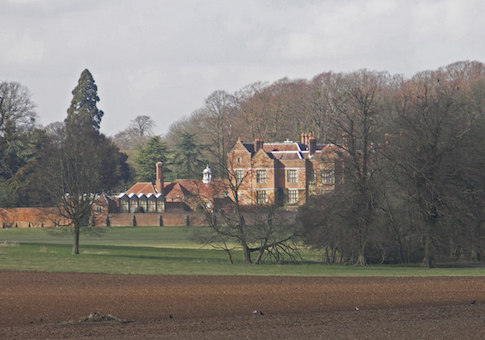I recently read a profile in Bloomberg of an oenophile turned reseller who cheated his wealthy clients—mostly San Francisco tech millionaires and shady Chinese real estate magnates—out of hundreds of thousands of dollars by taking orders for wines that he either kept for himself or never owned in the first place. He is now in prison.
I thought of him and all those bottles of La Mission Haut-Brion and Cheval Blanc—some 71,000 are still sitting in his warehouse, awaiting a buyer at what will no doubt be cut-rate prices—while reading Adrian Tinniswood’s wonderful new history of English country houses in the interwar period. For Tinniswood’s primary subjects at any rate, this was an age of opulence in which "a little something" for afternoon tea might consist of "buttered crumpets, buttered date and walnut loaf, cream cheese and pimento sandwiches, maids of honor [that is, puff pastry stuffed with cheese curds], coffee éclairs, chocolate sponge roll, and queen cakes." The mood here more often than not is one of gaiety, but sooner or later one expects the whole thing to come crashing down, like Sutton Scarsdale, the Nottinghamshire country house burned to the ground by a contractor after its Second Folios and Zoffanys and carved mantelpieces were sold off piecemeal.
Tinniswood is writing about a period of transition in which tortoiseshell tea caddies, cordial relations with the vicar, and liveried footmen whose only job was to hand out cigars to guests exist uneasily beside scandalously painted toenails, the automobile, and jazz; when Warwick Castle held parties to celebrate the return of Tory Government while one of the gateposts at Wallington Hall in Northumberland sported a hammer and sickle. A roaring trade was done in titles, which American tycoons were eager to acquire in exchange for daughters and liquidity. (When the Earl of Jersey married a film star in 1937, the anonymous editor of Debrett’s Peerage gamely listed the bride as Virginia Cherrill "of Hollywood, U.S.A.") At the end of the First World War, the word "weekend" itself was still considered a vulgar working-class synonym for what was properly called a "Saturday to Monday." When Lord Salisbury was prime minister at the turn of the century, he had three country seats; Lloyd George, at the end of the First World War, had none, which is how Chequers came to be donated to the nation as an official residence for the leader of His Majesty’s Government.
Tinniswood has organized his book on thematic rather than chronological lines. There are chapters about the houses owned by the royal family; Sir Edward Lutyens, the Arts and Crafts architect who designed the Cenotaph in London; interior design; sport; homosexuality; and the role of country houses in English politics. Certain delightful characters recur with some frequency regardless of the topic: Stanley Baldwin (who we see force P.G. Wodehouse upon a young charge accused of thinking too much), the lovely Elizabeth Bowes-Lyon and her husband the future George VI, who informs his parents of their engagement via a telegram reading "All right. Bertie," and (mostly via the screen) Charlie Chaplin. Even Edward VIII, whose hardy attitude towards gardening comes as a surprise, and Lloyd George, who was fond of showing films as a treat to his domestic staff, come off well here. Perhaps my favorite of all is Rosina Harrison, a witty Yorkshire-born maid who served the Cranbornes and Lady Astor. Tinniswood quotes a delightful passage from Harrison’s memoirs that shows us she knew how to deal with perverts at the British Embassy in Rome:
[One] night I was getting ready for bed and was standing in my voile knickers and vest when I saw a hand come round the edge of the door. I didn’t stop to think. I was over in a flash and pressing the door against the obtruding hand with all my strength. I watched it go red and then purple and I could hear some nasty Italian words uttered from the other side. … After that I slept easy.
This is not a book heavy with original research. Tinniswood’s sources, when they are not periodicals (he draws heavily on the archives of Country Life), are almost invariably published ones; indeed, many of them—the memoirs of John Buchan, the diaries of Harold Nicolson and "Chips" Channon—are classics. It is instead a triumph of selection and organization that reads like an amusing series of sketches rather than a continuous narrative.
There are occasional shoddy patches. "Newspaper tycoon William Randolph Hearst"—the anarthrous noun modifier comes only with his fourth appearance in the book—aside from being quasi-grammatical, insults the intelligence. The reader who would make it to page 194 of The Long Weekend before closing it in frustration because he has not been told who Hearst is simply does not exist; even if there were such people, and they were likely to open 300-page histories of country houses, they would give up on the first sentence of page one, when Tinniswood takes for granted that they know who John Galsworthy was. I wonder whether the text has been altered for the American edition.
Such slips, tedious as they are, are not representative of these pages, and at any rate those of us who read a great deal of contemporary nonfiction are beginning to get used to them. The Long Weekend is dessert reading, perfect for a Saturday afternoon binge.
